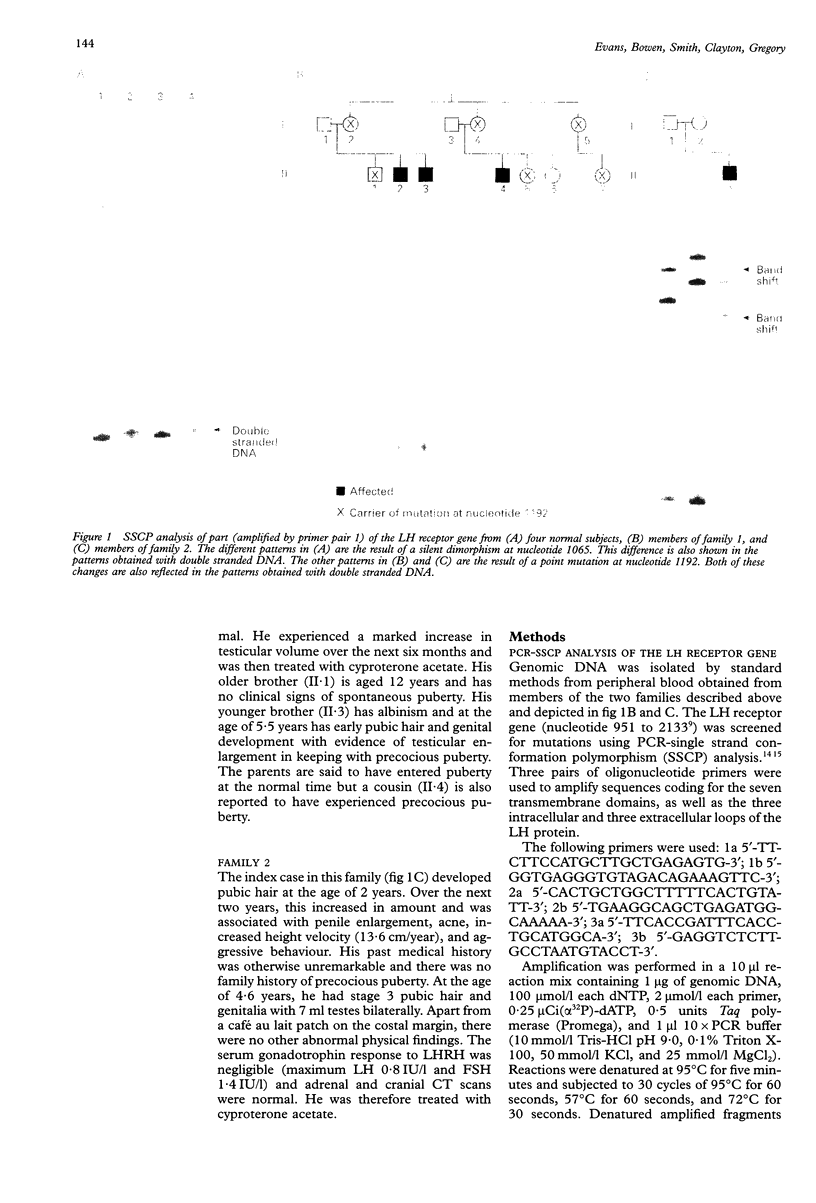Abstract
Genomic DNA from two families with male limited precocious puberty was examined for mutations of the LH receptor gene. In family 1, several members of the pedigree have FMPP, whereas in family 2 there is only one affected subject. A point mutation (T --> C at nucleotide 1192) resulting in substitution of threonine for methionine 398 in the second transmembrane domain of the LH receptor protein was found in both families. In addition, one member of family 1 has the mutation, but no evidence of precocious puberty. All obligate carriers within this family were shown to have the mutation, and it was not detected in 94 chromosomes from unaffected and unrelated white subjects. In family 2, the index case was the only one to have the mutation. A previously unreported neutral dimorphism (C --> T at nucleotide 1065) is also described.
Full text
PDF




Images in this article
Selected References
These references are in PubMed. This may not be the complete list of references from this article.
- Batch J. A., Williams D. M., Davies H. R., Brown B. D., Evans B. A., Hughes I. A., Patterson M. N. Androgen receptor gene mutations identified by SSCP in fourteen subjects with androgen insensitivity syndrome. Hum Mol Genet. 1992 Oct;1(7):497–503. doi: 10.1093/hmg/1.7.497. [DOI] [PubMed] [Google Scholar]
- Duprez L., Parma J., Van Sande J., Allgeier A., Leclère J., Schvartz C., Delisle M. J., Decoulx M., Orgiazzi J., Dumont J. Germline mutations in the thyrotropin receptor gene cause non-autoimmune autosomal dominant hyperthyroidism. Nat Genet. 1994 Jul;7(3):396–401. doi: 10.1038/ng0794-396. [DOI] [PubMed] [Google Scholar]
- Koo Y. B., Ji I., Slaughter R. G., Ji T. H. Structure of the luteinizing hormone receptor gene and multiple exons of the coding sequence. Endocrinology. 1991 May;128(5):2297–2308. doi: 10.1210/endo-128-5-2297. [DOI] [PubMed] [Google Scholar]
- Kremer H., Mariman E., Otten B. J., Moll G. W., Jr, Stoelinga G. B., Wit J. M., Jansen M., Drop S. L., Faas B., Ropers H. H. Cosegregation of missense mutations of the luteinizing hormone receptor gene with familial male-limited precocious puberty. Hum Mol Genet. 1993 Nov;2(11):1779–1783. doi: 10.1093/hmg/2.11.1779. [DOI] [PubMed] [Google Scholar]
- Laue L., Chan W. Y., Hsueh A. J., Kudo M., Hsu S. Y., Wu S. M., Blomberg L., Cutler G. B., Jr Genetic heterogeneity of constitutively activating mutations of the human luteinizing hormone receptor in familial male-limited precocious puberty. Proc Natl Acad Sci U S A. 1995 Mar 14;92(6):1906–1910. doi: 10.1073/pnas.92.6.1906. [DOI] [PMC free article] [PubMed] [Google Scholar]
- Minegishi T., Nakamura K., Takakura Y., Miyamoto K., Hasegawa Y., Ibuki Y., Igarashi M., Minegish T [corrected to Minegishi T. ]. Cloning and sequencing of human LH/hCG receptor cDNA. Biochem Biophys Res Commun. 1990 Nov 15;172(3):1049–1054. doi: 10.1016/0006-291x(90)91552-4. [DOI] [PubMed] [Google Scholar]
- Orita M., Suzuki Y., Sekiya T., Hayashi K. Rapid and sensitive detection of point mutations and DNA polymorphisms using the polymerase chain reaction. Genomics. 1989 Nov;5(4):874–879. doi: 10.1016/0888-7543(89)90129-8. [DOI] [PubMed] [Google Scholar]
- Parma J., Duprez L., Van Sande J., Cochaux P., Gervy C., Mockel J., Dumont J., Vassart G. Somatic mutations in the thyrotropin receptor gene cause hyperfunctioning thyroid adenomas. Nature. 1993 Oct 14;365(6447):649–651. doi: 10.1038/365649a0. [DOI] [PubMed] [Google Scholar]
- Pollak M. R., Brown E. M., Estep H. L., McLaine P. N., Kifor O., Park J., Hebert S. C., Seidman C. E., Seidman J. G. Autosomal dominant hypocalcaemia caused by a Ca(2+)-sensing receptor gene mutation. Nat Genet. 1994 Nov;8(3):303–307. doi: 10.1038/ng1194-303. [DOI] [PubMed] [Google Scholar]
- Robbins L. S., Nadeau J. H., Johnson K. R., Kelly M. A., Roselli-Rehfuss L., Baack E., Mountjoy K. G., Cone R. D. Pigmentation phenotypes of variant extension locus alleles result from point mutations that alter MSH receptor function. Cell. 1993 Mar 26;72(6):827–834. doi: 10.1016/0092-8674(93)90572-8. [DOI] [PubMed] [Google Scholar]
- Robinson P. R., Cohen G. B., Zhukovsky E. A., Oprian D. D. Constitutively active mutants of rhodopsin. Neuron. 1992 Oct;9(4):719–725. doi: 10.1016/0896-6273(92)90034-b. [DOI] [PubMed] [Google Scholar]
- Rosenthal S. M., Grumbach M. M., Kaplan S. L. Gonadotropin-independent familial sexual precocity with premature Leydig and germinal cell maturation (familial testotoxicosis): effects of a potent luteinizing hormone-releasing factor agonist and medroxyprogesterone acetate therapy in four cases. J Clin Endocrinol Metab. 1983 Sep;57(3):571–579. doi: 10.1210/jcem-57-3-571. [DOI] [PubMed] [Google Scholar]
- Savarese T. M., Fraser C. M. In vitro mutagenesis and the search for structure-function relationships among G protein-coupled receptors. Biochem J. 1992 Apr 1;283(Pt 1):1–19. doi: 10.1042/bj2830001. [DOI] [PMC free article] [PubMed] [Google Scholar]
- Shenker A., Laue L., Kosugi S., Merendino J. J., Jr, Minegishi T., Cutler G. B., Jr A constitutively activating mutation of the luteinizing hormone receptor in familial male precocious puberty. Nature. 1993 Oct 14;365(6447):652–654. doi: 10.1038/365652a0. [DOI] [PubMed] [Google Scholar]
- Sieving P. A., Richards J. E., Naarendorp F., Bingham E. L., Scott K., Alpern M. Dark-light: model for nightblindness from the human rhodopsin Gly-90-->Asp mutation. Proc Natl Acad Sci U S A. 1995 Jan 31;92(3):880–884. doi: 10.1073/pnas.92.3.880. [DOI] [PMC free article] [PubMed] [Google Scholar]
- Wierman M. E., Beardsworth D. E., Mansfield M. J., Badger T. M., Crawford J. D., Crigler J. F., Jr, Bode H. H., Loughlin J. S., Kushner D. C., Scully R. E. Puberty without gonadotropins. A unique mechanism of sexual development. N Engl J Med. 1985 Jan 10;312(2):65–72. doi: 10.1056/NEJM198501103120201. [DOI] [PubMed] [Google Scholar]
- Yano K., Hidaka A., Saji M., Polymeropoulos M. H., Okuno A., Kohn L. D., Cutler G. B., Jr A sporadic case of male-limited precocious puberty has the same constitutively activating point mutation in luteinizing hormone/choriogonadotropin receptor gene as familial cases. J Clin Endocrinol Metab. 1994 Dec;79(6):1818–1823. doi: 10.1210/jcem.79.6.7527413. [DOI] [PubMed] [Google Scholar]
- Yano K., Saji M., Hidaka A., Moriya N., Okuno A., Kohn L. D., Cutler G. B., Jr A new constitutively activating point mutation in the luteinizing hormone/choriogonadotropin receptor gene in cases of male-limited precocious puberty. J Clin Endocrinol Metab. 1995 Apr;80(4):1162–1168. doi: 10.1210/jcem.80.4.7714085. [DOI] [PubMed] [Google Scholar]





